What Polar Bears Eat: Insights into Their Diet and Ecology
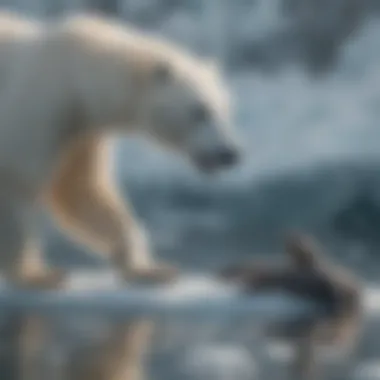
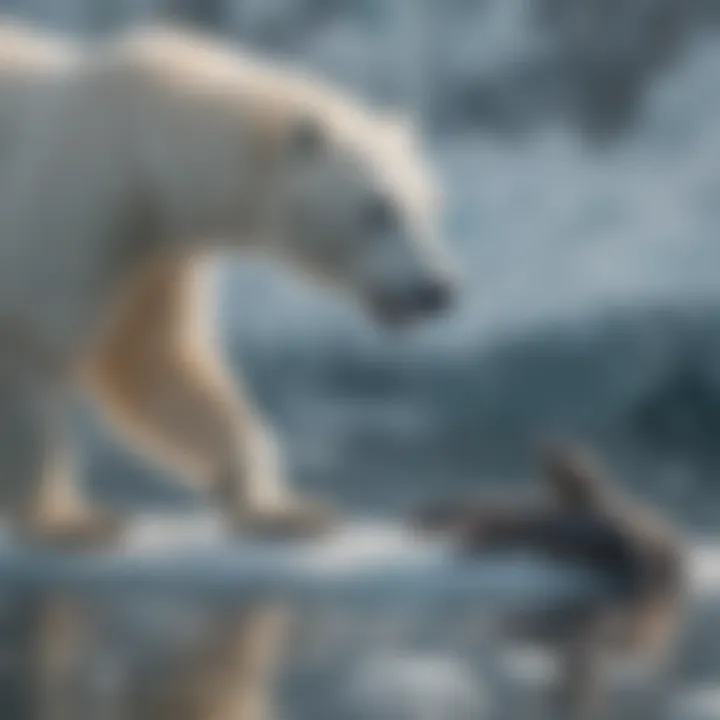
Nature Topic Overview
Polar bears are fascinating carnivorous mammals found in the Arctic region. Their diet is one of the most interesting aspects of their lives. Understanding what they eat gives a glimpse into their role in the environment. Their dietary habits offer insight into the state of the ecosystem.
Primarily, polar bears feed on seals, particularly the ringed seal and the bearded seal. Their hunting methods vary depending on the season and available ice cover. During winter months, ice is crucial for them to hunt. They often hunt seals by waiting near their breathing holes in the ice.
As the ice melts in the summer, bear's access to their food sources becomes limited. This change not only impacts their eating behaviors but laws also affects their body condition and overall survival.
Through examining what polar bears eat, we can see how climate change alters their natural habits. Climate change reduces ice habitat, putting pressure on polar bear survival. Understanding their diet highlights the challenges ahead and the urgency to address environmental conservation strategies.
Fun Facts and Trivia
- Did you know a polar bear’s fur is not really white but transparent? It reflects light, making it look white.
- A polar bear can swim for days, covering large distances in the sea searching for mates or food.
- Adult polar bears can weigh up to 1,500 pounds. That’s like having a small car weighing less than you!
Incorporating visuals, like the behaviors of polar bears while hunting, can help engage young readers. This can be done through posters or presentations in classrooms using pictures of these incredible animals during various seasons. Visual aids offer inspiration and ignite curiosity about nature.
Wildlife Explorations
Besides polar bears, numerous creatures share their Arctic habitat. Arctic foxes, for example, adapt well to this cold environment, often hunting rodents. They demonstrate an interesting interaction with their surrounding ecosystems.
Penguins, although not in the Arctic, are famous cold-weather creatures. Unlike polar bears, penguins cannot live in the Arctic, as they only thrive in the Southern Hemisphere.
Learners can create a small encyclopedia page on various animals in the animal lifecycle. Include fun facts and a quiz on what these arctic creatures consume. Such activities help children engage more and remember more about wildlife.
Environmental Awareness
Polar bears play a vital role in the marine ecosystem. The ice on which they depend is melting. This declining ice is troubling for others too. Seals and many marine species face risks as their homes turn unsafe.
Young people can play a significant role in saving our environment. Following actions add up:
- Encourage recycling and proper waste disposal practices.
- Learn to conserve water and energy daily.
- Inspire peers to advocate for safer practices by reducing plastic use.
Understanding these facts supports facts conservation awareness and the importance of fighting against global environmental issues.
DIY Nature Activities
Hands-on nature activities make learning fun. Consider:
- Creating a scavenger hunt. Search for materials around home and explain how they relate to nature and wildlife.
- Design a polar bear using white paper and develop a short story about its adventures with food.
- Conduc creator scrabblewords cards with the names of different animals that reside within the Arctic. Play this game with a few friends.
Through outdoor activities, knowledge about experiences inspired kids to explore and experiment in their environment while gaining a deeper respect for all life forms.
Understanding what polar bears eat enhances knowledge about their role in the environment. This is essential for the above understandings of ecology and should engage passion for exploration among groups of children and adults alike.
Foreword to Polar Bears
Understanding polar bears is essential to grasp their behavior, diet, and the challenges they face due to the changing environment. As one of the largest carnivorous land mammals, their dietary habits have significant implications for the Arctic ecosystem. Polar bears uniquely adapt their foraging and hunting techniques to survive in an extreme habitat. The details discussed here help provide clear insights into their characteristics and distribution, laying the groundwork for further exploration of their diet and ecological importance.
Characteristics of Polar Bears
Polar bears, scientifically known as Ursus maritimus, are distinctive creatures with compelling adaptations suited for life in icy regions. They can weigh between 900 to 1,600 pounds and measure around eight to ten feet in length. Heavy layers of blubber and fur insulate them against frigid temperatures, preventing heat loss. Another thing to note is the bear's white fur, which serves both camouflage and warmth protection.
Their paws are large and equipped with rough pads for traction on ice. These adaptations allow them to swim long distances in cold waters, which is critical for hunting seals. Despite their size, polar bears are capable of surprising agility. They can run up to 25 miles per hour over short distances. On an interesting note, polar bears have a keen sense of smell; they can detect a seal’s breathing hole from over a mile away.
Habitat and Distribution
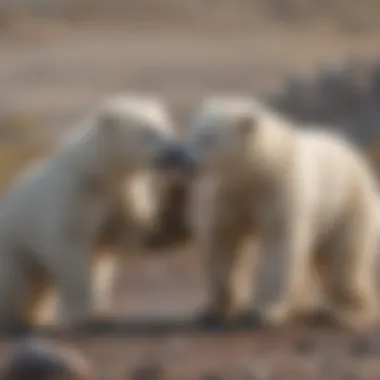
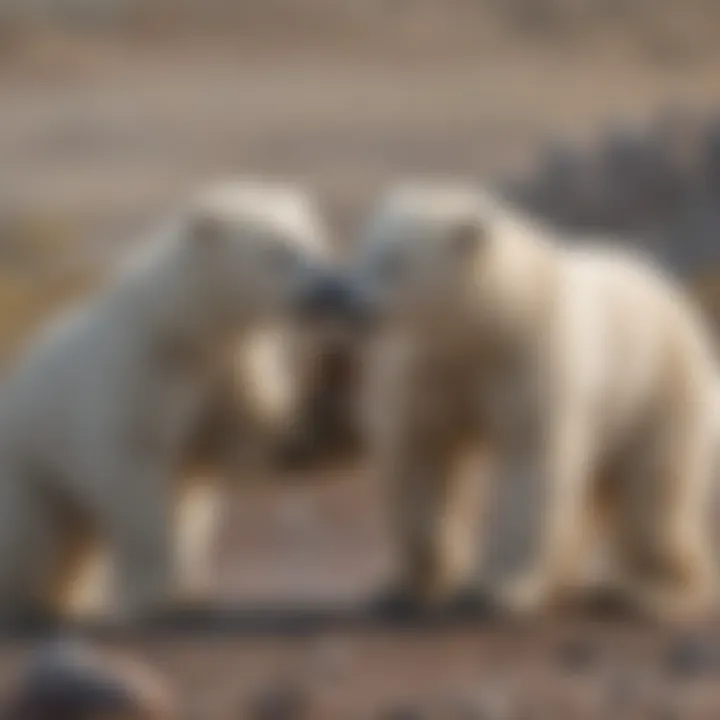
Polar bears primarily inhabit the circumpolar Arctic regions. This includes parts of Alaska, Canada, Greenland, Norway, and Russia. These vast areas are dominated by sea ice, which plays a crucial role in the bear’s life cycle. The bears spend much of their time on this ice, as it is the primary platform for hunting seals, their main prey.
Sea ice also enables them to travel large distances in search of food and mates. However, the distribution of polar bears is not uniform; they are often found in certain regions where the conditions are favorable for hunting. Coastal areas are particularly important as they provide access to rich food sources. The changing climate and warming temperatures affect their habitat, causing ice loss and influencing their behavior.
Overview of Polar Bear Diet
The diet of polar bears is a critical component of their existence in the Arctic ecosystem. Understanding what these animals eat is key to grasping their role in the environment. Their dietary habits not only impact their individual health but also influence the larger food web. By examining their diet, we can identify the necessitites for their prey species, which also face challenges due to climate change.
Carnivorous Nature
Polar bears are well-known for their carnivorous nature. They primarily rely on meat as their main source of nourishment. This adaptation is essential for their survival in the harsh conditions of the Arctic. Polar bears possess a unique physiological design that allows them to hunt effectively. For sheer sustenance, these animals have evolved behaviors and physical characteristics specially suited for hunting. Their sharp claws can tear through areas of thick ice, providing them access to their prey.
Feasting largely on seals, these apex predators maintain their position at the top of the food chain. Seals are rich in fat, which energize the polar bears and support their phenomenal size and strength. This species shows varied appetites based on food availability. Instead of dabbling in an omnivorous diet, they focus directly on energetically dense foods, which meet their needs considerably.
Key Food Sources
Polar bears have a few key food sources. While seals dominate their diet, other marine mammals also play a role. Below are their significant dietary components:
- Seals: Harbor seals and ringed seals remain foundational to polar bears. They chiefly hunt these seals through specialized techniques.
- Other Marine Mammals: Occasionally, polar bears will catch carcasses of other marine mammals, including walruses and whale remains. While these are not a primary source, they provide additional nutrition when seals are scarce.
- Birds and Eggs: On rare occasions, birds and their eggs might supplement the polar bear’s diet, especially during summer when seals become harder to hunt.
This overview of the polar bear diet enriches our understanding of their connection to the Arctic environment.
Understanding the prey dynamics and foraging behaviors of polar bears is fundamental to conservation efforts.
Primary Food Sources
Polar bears are supreme carnivores, and a solid grasp of their primary food sources is essential for understanding their survival in the Arctic ecosystem. Their diet mainly consist of marine animals that are adapted to the cold, icy conditions of this habitat. This section explores the key food sources for polar bears, emphasizing not just the items on their menu but also the ecological implications of their dietary patterns.
Seals as a Mainstay
Seals are the cornerstone of the polar bear diet. These animals provide not only a dense energy source but also the required fat content essential for survival. There are several types of seals that polar bears hunt. The most common seals consumed are ringed seals and bearded seals.
- Fat Content: Seals, especially of these types, are rich in blubber, offering polar bears the high caloric intake essential for fat reserves needed to endure the harsh Arctic winter.
- Hunting Season: Polar bears do most of their hunting in spring when seals give birth to pups. This is an opportune time as the pups are vulnerable.
By utilizing clever hunting techniques, such as waiting by the breathing holes of seals in the ice, polar bears maximize their foraging success.
Other Marine Mammals
Aside from seals, polar bears also hunt other marine mammals, making these additional food sources critical to their diets. While seals remain predominant, the following options add variety to their meals:
- Walruses: Though more challenging to capture, young walruses can provide a food source during summer months when seals are less plentiful.
- Beluga Whales: Polar bears may attack beluga whale calves. Though conducting such a hunt depends on the individual bear's ability, the reward can be significant due to the size of the whale.
Hunting these larger mammals demonstrates the adaptability of polar bears to their underwater hunting environments as needed.
Birds and Eggs
Birds and their eggs are another significant part of a polar bear's diet, particularly during certain seasons in the Arctic. While not as substantial as seals or marine mammals, they provide periodic dietary benefits:
- Eggs from Goose Nests: Polar bears may scavenge for eggs in bird nesting areas during spring and summer, particularly from geese which nest in close proximity to the sea.
- Adult Birds: Although comparatively less frequent, pelagic species may fall victim during their nesting cycles near scooped edgings of ice.
The hunt for birds and eggs typically serves as a supplementary food source, especially during periods when traditional prey is scarce.
In the Arctic, the diet of polar bears is as much about opportunistic foraging as it is about targeting specific prey.
The primary food sources of polar bears are not merely their sustenance but also a delicate balance that reflects the health of the Arctic ecosystem. This natural pyramid underscores the importance of preserving ice habitats and the broader implications of climate change on these extraordinary animals. Understanding their dietary behaviors is essential in addressing the ecological changes impacting polar bears today.
Foraging and Hunting Techniques
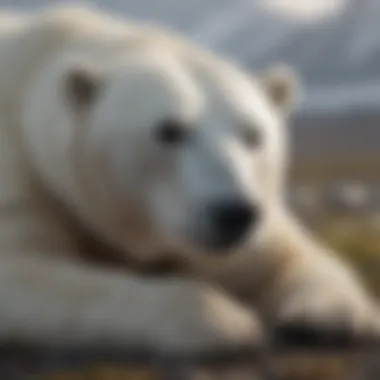
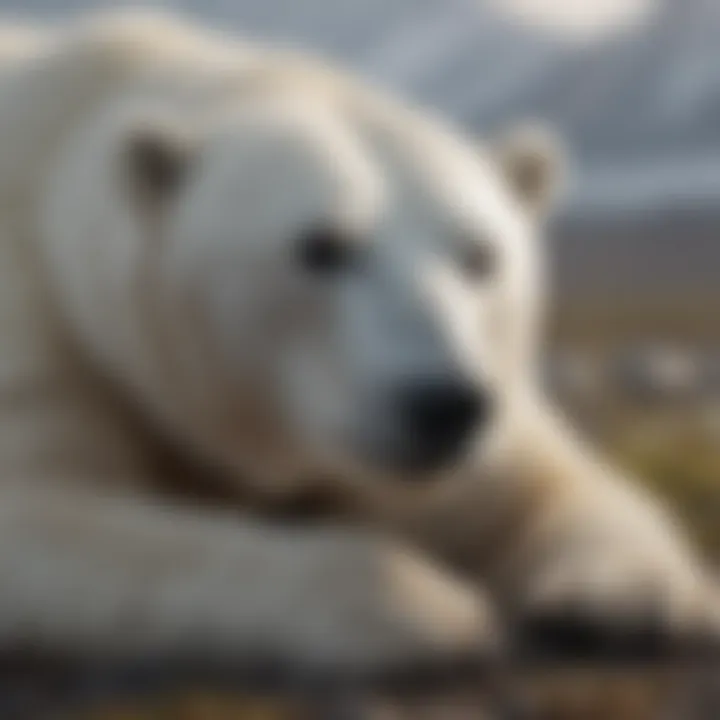
For polar bears, foraging and hunting techniques are ratt essential. These large carnivores have adapted to survive in one of the harshest habitats on the planet. Knowing how they hunt and find food can help us understand their role in the Arctic ecosystem.
Hunting Methods
Polar bears predominantly rely on three main hunting methods. Each technique is tailored for specific prey and conditions:
- Still-hunting: This involves detecting seals from a distance and waiting patiently near a breathing hole or on a patch of ice. Once a seal appears, the bear strikes quickly and effectively.
- Stalking: When bears encounter seals on ice, they approach quietly and then explode in sudden speed to capture their hunt. This skillful method requires stealth.
- Trophy hunting: Polar bears might also scavenge remains from other predators, showcasing opportunistic behavior. This technique maytake advantage of other opportunities when the primary food source is scarce.
Each hunting method presents benefits and challenges. For example, still-hunting can yield a reward when seals surface, but requires patience. Stalking relies on the bear's physical prowess and environmental awareness.
Role of Sea Ice in Hunting
The existence of sea ice greatly affects polar bears' hunting success. Sea ice serves as a platform for them to search for food. Without adequate sea ice, many bear populations struggle.
Key roles played by sea ice in hunting include:
- Access to prey: Sea ice is crucial for polar bears to reach their primary food sources like seals. This ice allows bears to be stealthy while hunting.
- Resting and stretching: When bears need to recover or regain energy, they often utilize ice, which provides a stable surface while they eat or rest.
However, climate change results in rapid melting of sea ice, affecting how polar bears can hunt. The decline in ice means bears must travel longer distances been food. Polar bears face significant challenges. This can impact their health and populations. Protecting sea ice is critical to securing food and stabilizing the Arctic ecosystem.
”In these logistically difficult circumstances, understanding polar bears can shape our conservation efforts.”
In summary, foraging and hunting techniques are central to polar bears' survival. Each method and the influence of sea ice consistently link back to their complex hunting dynamics. By protecting their habitats, we help sustain future populations of polar bears.
Seasonal Variations in Diet
Understanding the seasonal variations in the diet of polar bears is essential to recognizing their adaptive strategies for survival in a harsh environment. These variations dictate their foraging behavior, prey availability, and overall health. By examining how polar bears alter their meals throughout the year, we can uncover how they cope with changing conditions, ensuring their survival while maintaining their role in the Arctic ecosystem.
Summer Feeding Behaviors
During the summer months, polar bears face unique challenges. As ice melts away, seals become somewhat elusive. Despite the difficulty, bears adapt their foraging behaviors to capitalize on available resources. In summer, the primary focus shifts to land-based food sources. This may include bird eggs, various types of vegetation, and even carrion.
Their challenge stems from limited access to seals, which requires bears to travel greater distances. Thus, they exhibit increased nomadism, having to venture further inland where grass and berry patches can offer nourishment. The summer foraging efforts play a large role in building up body fats for the colder months ahead.
Winter Feeding Patterns
As the traditional hunting grounds freeze over in winter, polar bears return to a more marine-centric diet. Ice formation provides prime opportunities for hunting seals, their main prey. Hunting methods adjust significantly during this time, as bears rely on sea ice to stalk seals lazing on the surface or breathe holes.
Despite having access to their primary food source, not all bears will thrive. The swift competition and limited resources often result in some bears struggling to make enough of a food intake. Thus, the interplay of weather, sea ice conditions, and prey can strongly influence their successful winter sustenance.
Nutritional Needs of Polar Bears
Understanding the nutrition al needs of polar bears is crucial. These large carnivorous mammals have specific diets to inc,lude crucial nutrients that meet their energy requirements. It impacts their overall health, reproductive success, and survival rates. The polar bear's diet is comparatively high in fat, proteins, and vitamins, primarily from their primary food sources. By examining these nutritional needs, we can better appreciate the challenges these animals face in their, shifting environment.
Caloric Requirements
To survive in the harsh Arctic, a polar bear needs a substantial amount of calories. Adult male polar bears can require between
- 22,000 to 32,000 calories daily during the summer.
- While females require up tо 10,000 calories under normal circumstances and more during lactation.
To maintain their body weight, their diet relies heavily on seal blubber. With a high-calorie extracted from fat, it serves a requirăed energy source crucial during fasting periods, especially during migration or breeding seasons. Not all calories are equal; polar bears aim to consume dense calorie sources to meet their high energy demands.
Impact of Diet on Health
A proper diet directly influences the health of polar bears. Its imbalances can lead to consequences affecting their fitness and breeding capabilities. Adequate nutrition plays a major ro-le in:
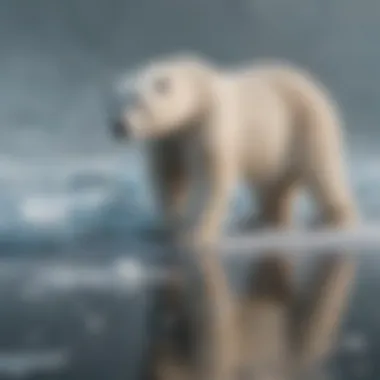
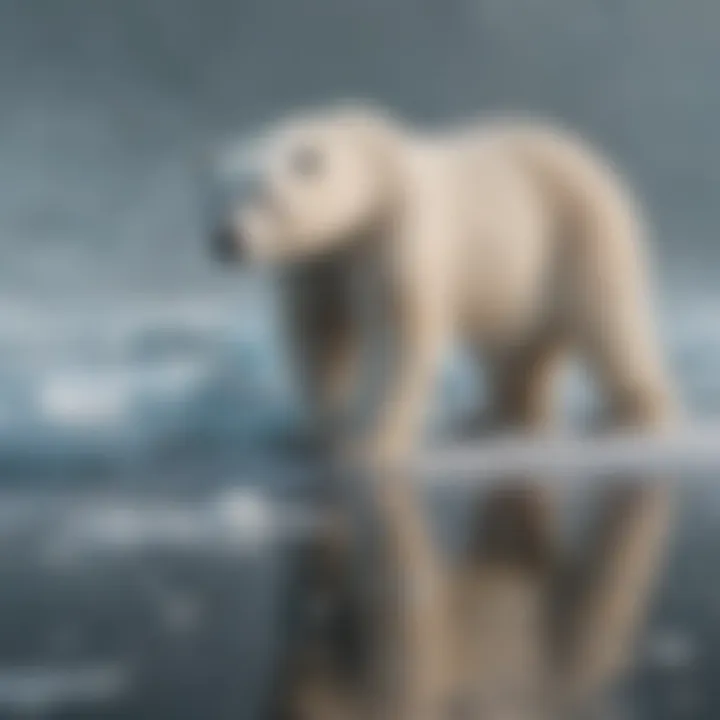
- Maintaining a healthy weight,
- Supporting the immune system, and
- Enhancing reproductive success.
Nutritional deficiencies cannot attract not only their overall saarvel, but could lead to malnourished offspring, impacting long-term population sustainability regarding environmental changes. A special focus on their food sources also shows how diet influences their adaptability to climatic shift. Understanding the needs of polar bears reveals not just individual health data but Insights About the Arctic ecosystem overall. This highlights how essential it is to, maintain their natural habitats in grasp of climate change As a conclusion, considering the calArizona rainforest ready-waterdan scarшy ice habitats will show clear patterns on how their diets balance on servam emissions in enjoy for their reduced survival.Apurpose
Impact of Climate Change on Diet
Understanding how climate change affects the diet of polar bears is essential. This knowledge helps us grasp broader ecological shifts in the Arctic environment. The changes in climate directly impact the availability of food sources crucial for these bears. When the conditions in their habitat change, bears struggle to find the nourishment they require. Therefore, studying this impact informs conservation efforts.
Loss of Sea Ice
Sea ice serves as a vital platform for polar bears to hunt. As temperatures rise, ice melts earlier and forms later, which alters the hunting grounds. Bears rely heavily on seals that stay near the ice edge. With less ice, hunting becomes more challenging since bears have to swim longer distances, making them expend more energy.
Also, reduced sea ice limits the access to traditional hunting spots. A study showed that some bears are now venturing into areas they rarely visited before, searching for food. This shift could lead to an increase in human-bear interactions, creating challenges for both humans and bears. The overarching trend is clear: as sea ice diminishes, polar bears face harder times securing their essential calories.
Changes in Prey Availability
Along with the loss of sea ice, climate change affects the ecosystem, changing the behavior and populations of prey. As water temperatures rise, the distribution of seals and other marine mammals may shift, leading to potential food scarcity for polar bears.
Additionally, reduced ice cover may affect the breeding patterns of seals. Without ample ice, seal pups, which are a crucial food source for polar bears, struggle to survive. Tape-seal and ringed-seal populations might see declines in numbers, directly affecting the bears’ diets.
Only through understanding can we become effective advocates for the beings we share our world with.
Conservation of Polar Bears
The conservation of polar bears is a crucial topic within the scope of understanding their eating habits and general well-being. These majestic mammals play a vital role in the Arctic ecosystem, serving as top predators.Caring for polar bears means protecting their habitat, as their survival is intricately connected to the health of their environment. Due to climate change, polar bear populations have been affected significantly.
The polar bears rely heavily on sea ice for hunting and breeding. As temperatures rise, the sea ice diminishes, creating more challenges for their survival.
Maintaining healthy polar bear populations isn’t just about safeguarding the bears themselves. There are broader ecological consequences at play. Here are a few key points emphasizing the significance of polar bear conservation:
- Biodiversity: Polar bears are essential to the Arctic habitat. Their presence helps control the populations of seals and other marine animals, which in turn supports the whole food web.
- Climate Indicators: Polar bears are indicators of the state of the ecosystem. A decline in cubs or adult bears can signal that something is wrong with their habitat, aligning with broader climate trends.
- Cultural Importance: These animals hold cultural value for some Indigenous peoples. Their survival affects cultural traditions and practices tied to wildlife.
Addressing climate change poses a potent strategy for polar bear conservation. Ensuring their continued existence relies on concerted efforts to mitigate environmental threats. This leads us to the critical ideas of understanding their role within their ecosystem.
Understanding Their Role in the Ecosystem
Polar bears fit into a larger ecological framework, affecting not just their immediate surroundings but the entire Arctic environment. Their role can be outlined in several aspects:
- Predation: By preying primarily on seals, polar bears help maintain a balance in the population of these marine mammals, which could otherwise overpopulate and disrupt the ecosystem.
- Nutrient Cycling: Polar bear waste products provide nutrients to the Arctic waters. When they catch a seal, bits of the seal can become part of the underwater ecosystem.
- Habitat Creation: As polar bears sometimes cover newly-created ice and snow, it allows for plant growth and other marine species to take hold in these habitats.
Recognizing these highlighted roles emphasizes how conserving polar bears goes beyond simply protecting a species. It involves preserving a healthy ecosystem where multiple life forms can exist and thrive together.
Efforts to Protect Polar Bear Habitats
In recognizing the challenges, there are various efforts being made to protect polar bear habitats. These efforts range from local initiatives to global conservation strategies:
- Protected Areas: Establishing marine and terrestrial protected areas helps create safe spaces for polar bears to hunt, breed, and live without disturbances from human activities, such as oil drilling or commercial fishing.
- Legal Regulations: The balance between hunting rights for indigenous peoples and sustainable management practices is a goal of ongoing debate. Understanding these complex relationships provides ways to craft effective policies.
- Research Initiatives: Data collection through field studies and satellite tracking is vital for understanding polar bear behavior, thus guiding future conservation efforts.
It's necessary to develop holistic approaches, combining ecological science with effective policy decisions. Protecting polar bear habitats is not only crucial for their survival. It’s essential for the stability of the Arctic environment overall.
End
Understanding the diet of polar bears is crucial not just for ecological reasons but also for conservation priorities. These magnificent creatures act as apex predators and play an essential role in the Arctic ecosystem. By knowing what they eat, we can gain idduolar insights into their behavior, population health, and the overall health of their habitats.
Polar bears primarily rely on seals for sustenance, and their connection to this food source highlights the delicate balance of the Arctic food web. As the ice disappears due to climate change, this reliance creates a direct link between their diet and environmental preservation. Hence, protecting their main food source serves as a critical focal point for conservation efforts.
While there are numerous factors at play, grasping the overall picture of polar bears’ dietary habits fosters a deeper understanding of the challenges they face. Not only does this contribute to scientific knowledge, but it also aligns with broader conservation messages that influence policy making.
Summarizing Polar Bear Diet
In summary, polar bears mainly consume seals, particularly ringed and bearded seals, which are high in fat content essential for their caloric needs. During summer, they adjust their diet and may include lesser prey like birds and eggs when seals are less accessible. Winter offers an opportunistic feeding strategy dominated by seal hunting facilitated by the structure of sea ice, which is vital for their hunting behavior.
With this intricate approach to feeding, polar bears not only succeed as predators, but also shape the ecological framework of their environment. As changes in climate further affect their prey availability, it raises significant concern about their ability to thrive in an evolving ecosystem. Strengthening our understanding of their dietary habits thus becomes imperative, not just for their survival, but for the health of the Arctic as a whole.







